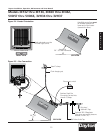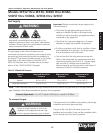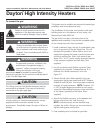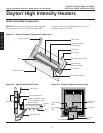
®
Dayton Installation, Operation, Maintenance and Parts Manual
Models 3E132 thru 3E134, 3E460 thru 3E462,
5VD57 thru 5VD66, 3VH34 thru 3VH37
E
N
G
L
I
S
H
21
Symptom Possible Cause Corrective Action
Burning of gas-air
mixture inside
plenum (flashback).
• Heater mounted at incorrect angle.
• Excessive drafts.
• Gas leaking or blocked orifice/venturi.
• Separation of ceramic grids.
• Ceramic grids cracked.
• Mounting angle 20°-35° from horizontal.
• Relocate or shield from draft.
• Do not operate unit. Check with leak detector solution.
• Do not operate unit. Replace rayhead.
• Do not operate unit. Replace rayhead.
Delayed ignition. • Electrode out of specification.
• Low gas pressure.
• Partially blocked orifice.
• Improper orifice size.
• Incorrect gas.
• See figure 4.2.
• See Gas Supply section.
• Clean or replace.
• Consult dealer.
• Do not operate unit. See unit nameplate. Correct immediately.
Low ceramic surface
temperature, excessive
rollout or soot on
rods.
• Dirty or plugged rayhead ceramics.
• Partially blocked orifice.
• Low inlet gas pressure.
• Low manifold gas pressure.
• High manifold pressure.
• Foreign matter in venturi tube.
• Gas supply piping too small .
• Incorrect gas.
• See maintenance instructions.
• Remove and clean.
• See Gas Supply section.
• Adjust main valve regulator for 6” W.C.P. natural gas,
10” W.C.P. propane.
• Adjust main valve regulator for 6” W.C.P. natural gas,
10” W.C. P. propane.
• See periodic maintenance instructions.
• Increase inlet pressure or replace.
• Do not operate unit. See unit nameplate. Correct immediately.
Control system
overheating.
• Heater not mounted correctly.
• Heater mounted too close to ceiling.
• Mounting angle 20º-35º from horizontal.
• Observe clearance to combustibles safety chart located on heater
reflector. Do not operate unit.
Gas odor. • Loose pipe connection. • Check all connections with leak-detector solution,
tighten as necessary.
Heater cycles
repeatedly.
• Heater located in drafty area.
• Low gas pressure.
• Thermostat located in drafty area.
• Weak pilot flame.
• Relocate or shield from draft.
• See Gas Supply section for propane.
• Replace thermostat.
• Clean or adjust pilot.
No spark; no ignition. • Lack of 120V or 24V incoming voltage.
• Open high voltage wire.
• Improper electrode gap.
• Loose or open wire connection.
• Poor or no equipment ground.
• Unit in “safety lockout” mode.
• Defective “gas lighter” control.
• Proper voltage needed or repair wire.
• Isolate and ohm for resistance, replace if “0”.
• See figure 4.2.
• Check all wires, tighten or replace.
• Trace ground wire for complete circuit back to equipment ground from
control.
• Interrupt power source, repeat trial for ignition.
• Verify proper voltage. Replace.
Heater lights, and
“locks out” after
approximately 10
seconds.
• Poor or no equipment ground.
• Polarity is reversed.
• Low gas pressure.
• Electrode not sensing.
• Heater mounted at incorrect angle.
• Check all connections, provide positive earth
ground.
• 120V to black, neutral to white.
• See Gas Supply section.
• Relocate or replace if defective.
• Mounting angle 20°-35° from horizontal.
Spark is present. No
main gas operation.
Unit “locks out”.
• Gas valve in “Off” position.
• Defective main valve solenoid.
• Defective “Gas lighter” control.
• Turn to “On” position.
• Isolate and check for resistance. Replace if “0”.
• Verify proper voltage. Replace.
Heater will not
shut off.
• Defective thermostat or wiring.
• Gas valve stuck open.
• High gas pressure.
• Replace or repair.
• Replace.
• See Gas Supply section.
Chart 4.1 Troubleshooting Guide


















